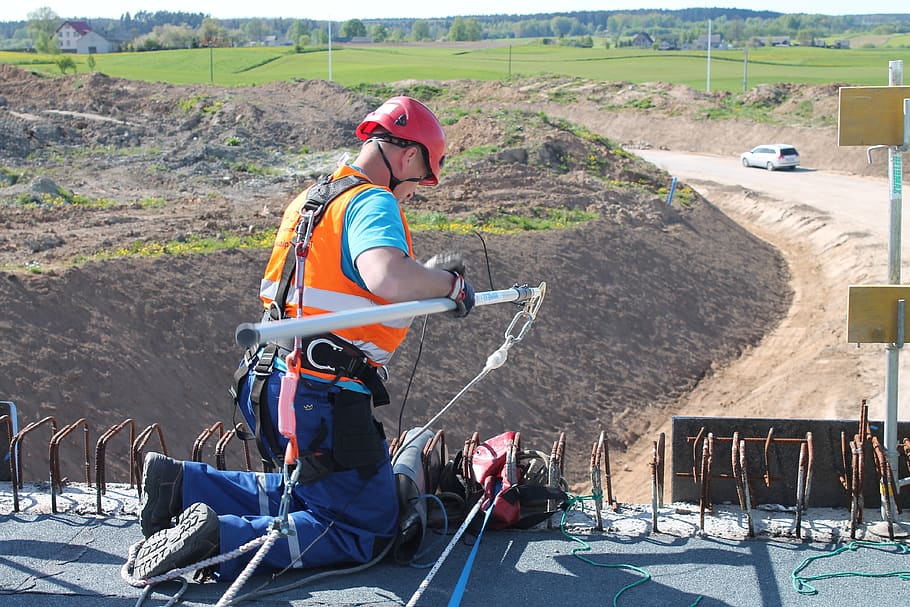Work at height rescue plan
Contents |
[edit] Introduction
The Work at Height Regulations (2005) define work at height as:
- work in any place, including a place at or below ground level;
- obtaining access to or egress from such place while at work, except by a staircase in a permanent workplace;
where, if measures required by the regulations were not taken, a person could fall a distance liable to cause personal injury.
The regulations impose duties on:
[edit] Rescue plan overview
Where work at height is necessary (typically when fall arrest systems are in use), duty holders are required by law to ensure that work at height is properly planned and organised. This means duty holders are obliged to have a rescue plan in place, which ensures that a worker can be retrieved as soon as possible if a fall occurs.
A rescue plan is a pre-planned procedure designed to safely retrieve someone who has fallen from height and is in a potentially dangerous position. The plan provides information about the type and location of rescue equipment that is vital in the rescue process.
The Health and Safety Executive suggests duty holders make several considerations in their plans, including:
- What will be the anchor point for the safety equipment?
- What type of weather could compromise worker safety?
- Will the rescuers be safe when carrying out the procedure?
- Is the equipment the individual was using no longer safe?
- How will the individual be attached to the rescue kit once they are reached?
- How will they be moved once the rescue team reaches them?
[edit] Competent rescuers
During work at height rescue situations, emergency rescue arrangements should not rely on the fire brigade or emergency services. Waiting for emergency services may be critical, and it is not their duty to rescue a fallen worker.
The Work at Height Regulations 2005 state that all activities, including the rescue, are the responsibility of the employer and should be carried out promptly by competent people within the organisation who fully understand the plan. Potential rescuers should be screened for sufficient skills and experience to perform rescue operations.
Rescue typically involves the recovery of a casualty by another person either remotely or directly. This differs from an evacuation, which is typically carried out by a stranded user to escape from a remote situation such as a tower crane.
Carrying out rescues and the use of rescue equipment requires technical capability in addition to the ability to use personal fall protection. There are also specialised rescue kits designed for extreme cases in which a rescuer needs to be lowered head-first into a confined space to perform a rescue. Regular training may be required for the designated rescuer to maintain competence in these types of systems.
[edit] Related articles on Designing Buildings
- Competent person.
- CONIAC produces essential messages on safe work at height.
- Fall prevention systems.
- Health and Safety.
- Injuries on construction sites.
- Work at height.
- Work at height checklist for managers.
- Work at height regulations.
- Working at height - our duty to prevent harm and protect each other.
- Working at height training.
[edit] External resources
Featured articles and news
BSRIA Sentinel Clerk of Works Training Case Study
Strengthening expertise to enhance service delivery with integrated cutting-edge industry knowledge.
Impact report from the Supply Chain Sustainability School
Free sustainability skills, training and support delivered to thousands of UK companies to help cut carbon.
The Building Safety Forum at the Installershow 2025
With speakers confirmed for 24 June as part of Building Safety Week.
The UK’s largest air pollution campaign.
Future Homes Standard, now includes solar, but what else?
Will the new standard, due to in the Autumn, go far enough in terms of performance ?
BSRIA Briefing: Cleaner Air, Better tomorrow
A look back at issues relating to inside and outside air quality, discussed during the BSRIA briefing in 2023.
Restoring Abbotsford's hothouse
Bringing the writer Walter Scott's garden to life.
Reflections on the spending review with CIAT.
Retired firefighter cycles world to raise Grenfell funds
Leaving on 14 June 2025 Stephen will raise money for youth and schools through the Grenfell Foundation.
Key points for construction at a glance with industry reactions.
Functionality, visibility and sustainability
The simpler approach to specification.
Architects, architecture, buildings, and inspiration in film
The close ties between makers and the movies, with our long list of suggested viewing.
SELECT three-point plan for action issued to MSPs
Call for Scottish regulation, green skills and recognition of electrotechnical industry as part of a manifesto for Scottish Parliamentary elections.
UCEM becomes the University of the Built Environment
Major milestone in its 106-year history, follows recent merger with London School of Architecture (LSE).
Professional practical experience for Architects in training
The long process to transform the nature of education and professional practical experience in the Architecture profession following recent reports.
A people-first approach to retrofit
Moving away from the destructive paradigm of fabric-first.
New guide for clients launched at Houses of Parliament
'There has never been a more important time for clients to step up and ...ask the right questions'
The impact of recycled slate tiles
Innovation across the decades.
EPC changes for existing buildings
Changes and their context as the new RdSAP methodology comes into use from 15 June.

























